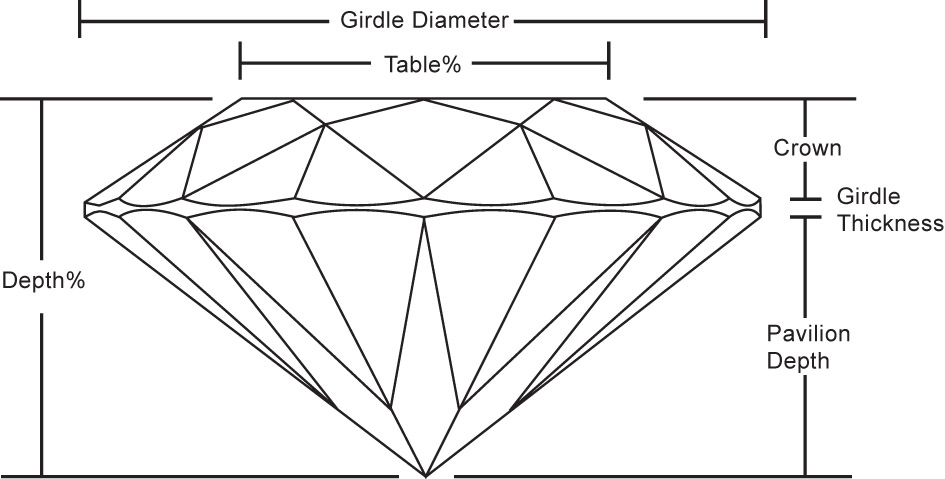Advanced Features Guide by Piyush Ratnu
Aside from the renowned 4 C’s, there are a handful of additional features which affect the quality and appearance of a diamond, and these should be taken into consideration when buying diamond jewelry. In order for you to make an educated purchase, we have assembled some supplementary information concerning a few of the more important advanced features of diamonds, which have an effect on their GIA grading process. These include a diamond’s depth, polish, table, symmetry, and fluorescence.

A Diamond’s Depth Percentage
A diamond’s depth refers to the measurement from table to culet. Another important related term is Diamond Depth Percentage. It is calculated by simply dividing the depth of the stone by its diameter, at its widest point. The depth percentage of a diamond affects its appearance in a number of manners. First of all, it influences the brilliance of the stone. If the diamond depth percentage is low, light will not reflect off it as well as it would reflect off a diamond with a higher depth percentage, and it will have less shine. The ideal diamond depth percentage falls between 58%-60%. Of course, this is only one feature out of several which affect a diamond’s brilliance. In addition, if size matters to you, keep in mind that a deep diamond may appear larger than a diamond of the same carat weight, which is not as deep.
A Diamond’s Polish
While the polish of a diamond does not influence its value, it affects its appearance to a great extent. It determines how well light will pass through the stone, and thus it has a direct influence on its shine. The best polish levels of a diamond are referred to as Good, Very Good, and Excellent. Diamonds with polish levels rated Poor to Extremely Poor possess polish lines which cloud up the diamonds’ facets, and the light within them is reduced respectively. Make sure your diamond is properly polished before making a purchase. The difference a thorough polish can make in a stone’s brilliance is astounding.
A Diamond’s Table Percentage
The table of a diamond is the flat facet on the top of the stone. Table Percentage refers to the ratio of the table width to the total diameter of the diamond, and has a significant effect on the brilliance and fire of the diamond. For the popular round diamond cut, the ideal table size is 53% of the diamond’s total width. Elongated diamonds usually fetch a far lower price than stones with a greater table size which possess the same carat weight, because their small tables reduce their shine considerably, as it is a critical reflector of light. Other diamond cuts have different ideal table sizes. Emerald, radiant, and princess cuts should have a table size ranging from 75%-80% of the stone’s total width. In other cuts, the table size should fall between 53%-58% for maximum brilliance and fire.
A Diamond’s Symmetry
The symmetry of a diamond affects the stone’s brilliance and value. The GIA’s symmetry levels range from Extremely Poor to Excellent. Ideally, when purchasing a diamond, you should make sure its symmetry rate falls between Good and Excellent. These levels should be verified on the GIA certificate, as they are very difficult to determine with the naked eye. A stone’s symmetry is rated based on the number and shape of its facets, the shape of its girdle and the positioning of its table and culet. When a diamond’s clarity level is low, its symmetry or lack thereof is far less noticeable and therefore it exerts less influence on a diamond’s value. The symmetry of a very clear stone is more visible and therefore plays a more significant role in determining its value.
A Diamond’s Fluorescence
The fluorescence of a diamond is a type of illumination which the stone exhibits when exposed to ultraviolet radiation. A certain degree of fluorescence is very common in diamonds, and Faint to Medium level fluorescence does not affect the appearance or value of the stone. Low levels of fluorescence are impossible to detect with the naked eye under regular lighting; it can be seen with the assistance of an ultraviolet lamp, under which a fluorescent stone will emit a bluish glow. If a stone’s fluorescence level is rated Very Strong or Extreme, it may appear cloudy. Intriguingly, however, Strong fluorescence may improve the appearance of diamonds which have a color rate of H or lower.
[contact_form]
